
Each community water system (CWS) provides an annual water quality report to
its customers. This annual water quality report is also called a Consumer
Confidence Report (CCR). The CCR includes a variety of important information
about a CWS, including the drinking water source, any monitored contaminants
found in drinking water, and whether a CWS meets state and federal drinking
water standards. The CCR is an opportunity for CWSs to communicate with their
customers and raise awareness about the source of their drinking water. CCRs
also give information that allows customers to make better decisions about their
health.
A CWS must deliver its CCR to customers by July 1st of each year. It must also
make a good faith effort to deliver the CCR to consumers who do not directly
pay water bills. This factsheet is intended to help CWSs design CCRs that better
educate customers about their drinking water. It contains recommended best
practices regarding the design, look and information in a CCR (Part 1). It also
includes tips for successful CCR electronic delivery (Part 2). Better designed CCRs
delivered in the way a customer prefers shows a CWS’s commitment to both
public health and the public's right-to-know. A well-designed CCR can help a
CWS educate its customers about this essential service and promote
involvement in protecting their drinking water.
1

2
This section describes recommended best practices for presenting required elements and other useful
information in your CCR.
What Information Is Required in a CCR?
There are eight elements that must be included in a CCR. These eight elements are the minimum information
that every CCR must contain, and include:
1. Water system information (name and
phone number of a contact person;
information on public participation
opportunities)
2. Source(s) of water
3. Definitions
4. Detected contaminant table
5. Information on monitoring for
Cryptosporidium, radon and other
contaminants (if detected)
6. Compliance with National Primary Drinking
Water Regulations (for example,
explanation of violations, potential health
effects, and corrective action steps; special
notices for Ground Water Rule and Revised
Total Coliform Rule)
7. If applicable, variances or exemptions (for
example, under certain conditions the state or EPA may have granted permission not to meet an
maximum contaminant level [MCL] or a treatment technique)
8. Required additional information (such as, explanation of contaminants in drinking water and bottled
water; information to vulnerable populations about Cryptosporidium; statements on nitrate, lead and
arsenic.)
What Else Should I Consider Including in My CCR?
The purpose of the CCR is to provide customers with information about their CWS that helps them make
informed choices about their drinking water. The required eight elements probably do not cover everything
you do to provide safe drinking water and to protect your customers’ health. Below is a list of ideas to
consider including in your CCR. Consider your audience when writing these optional CCR sections. Use words
that are clear and easy to understand; try not to use technical terms or acronyms. You want to be sure that
your customers learn about their CWS when they read their CCR and are satisfied with the service provided.
Figure 1. Example CCR of the Town of Anytown.

3
Tips: Things to consider including in your CCR
1. An explanation or diagram of your CWS’s treatment processes.
Photographs or schematics could be used as well, so customers
understand how the treatment process helps ensure their water
meets drinking water standards.
2. Additional information on where your source water is
geographically located (for example, maps, pictures of sources as
seen in Figure 2). Explain why the protection of these areas is vital
to public health protection.
Figure 2. Source of our drinking
water.
3. A brief summary statement about the quality of your drinking
water. Not everyone will have time to read the whole CCR, so be
sure that the big message gets across right away.
4. Water conservation tips (for example, benefits of WaterSense
products, rain barrel programs, irrigation timers, etc.). These tips
can help remind your customer that water is a precious resource.
5. The cost of making the water safe to drink, including the cost of
maintaining your infrastructure, so customers understand what
their water bill is covering.
6. Information about efforts you may have made to promote “green
infrastructure” (for example, Figure 3 shows a picture of
stormwater pollution prevention measures). This shows you are
active in preserving water quality as well; it’s a team effort.
Figure 3. Stormwater drain to
promote “green infrastructure.”
7. A statement from the mayor, town administrator or general
manager describing the importance of the CCR and the hard work
the CWS does every day to provide safe and reliable drinking water.
People take notice when their public servant takes notice.
8. Information to educate customers about water quality concerns in
their service area (for example, taste and odor issues, cross
connections). You can show that you are hearing their concerns
from your customer service representatives and working to address
these issues.
9. Photos that illustrate people enjoying their water or people taking
actions that you want your customers to copy. Include pictures of
consumers drinking water and be sure to include their faces and
eyes in the photos. For example, if you are asking customers to limit
the amount of time they water their lawns by using a sprinkler
timer, then show a photo of someone adjusting their sprinkler timer
(see Figure 4). If there was a trash clean-up in your watershed,
include before and after photos of people with trash bags to show
how much impact the clean-up had.
Figure 4. Adjusting a sprinkler
system.

4
10. Highlight improvements your CWS made throughout the year to
ensure a safe, reliable supply of drinking water, (for example,
efforts taken to reduce water leakage). You may instill confidence in
your customers that ongoing maintenance is ensuring the high
quality of their drinking water.
11. Information and images about how your CWS is protecting the
environment (for example, Figure 5 shows the installation of solar
panels at the CWS, initiating a recycling program). Your customers
will appreciate that you are trying to be green.
Figure 5. Solar panels reducing
energy cost at the water
treatment system.
12. Introduce the staff of your CWS by highlighting one person each
year, or include pictures of your operators fixing pipes. You can also
include an “employee spotlight” on your website to show the public
that the staff of the CWS are regular hard working people just like
the rest of the community.
The tips above are intended to help you help your customers appreciate their drinking water as the
significantly valuable resource it is and the work you do to protect and manage this resource.
Using Photos
Well-placed, high quality photos can add visual depth and personal context to your CCR. Remember to follow
copyright protocols to ensure legal use of the images in your CCR. Consider using photos you have taken of
your watershed and infrastructure. If someone else took a photo you wish to include, or if anyone is in the
photo, be sure to obtain their written permission before using the image. Pay attention to usage rights of any
photo you find online to ensure that they are publicly available for use, and avoid using images that show
brand names in your CCR.
What Are Best Practices for Creating a CCR Contaminant Table?
One required element of the CCR is the detected regulated contaminants table (or tables). You should present
these results in the table so that your customers will understand them. Figure 6 incorporates best practices
from CCRs across the country.

5
Figure 6. CCR Detected Regulated Contaminants Table showing best practices.
Health Effects
Barium: Some people who drink water containing barium in excess of the MCL over many years could experience an increase in their
blood pressure.
Total Coliform: Coliforms are bacteria that are naturally present in the environment and are used as an indicator that other,
potentially-harmful, bacteria may be present. Coliforms were found in more samples than allowed and this was a warning of
potential problems.
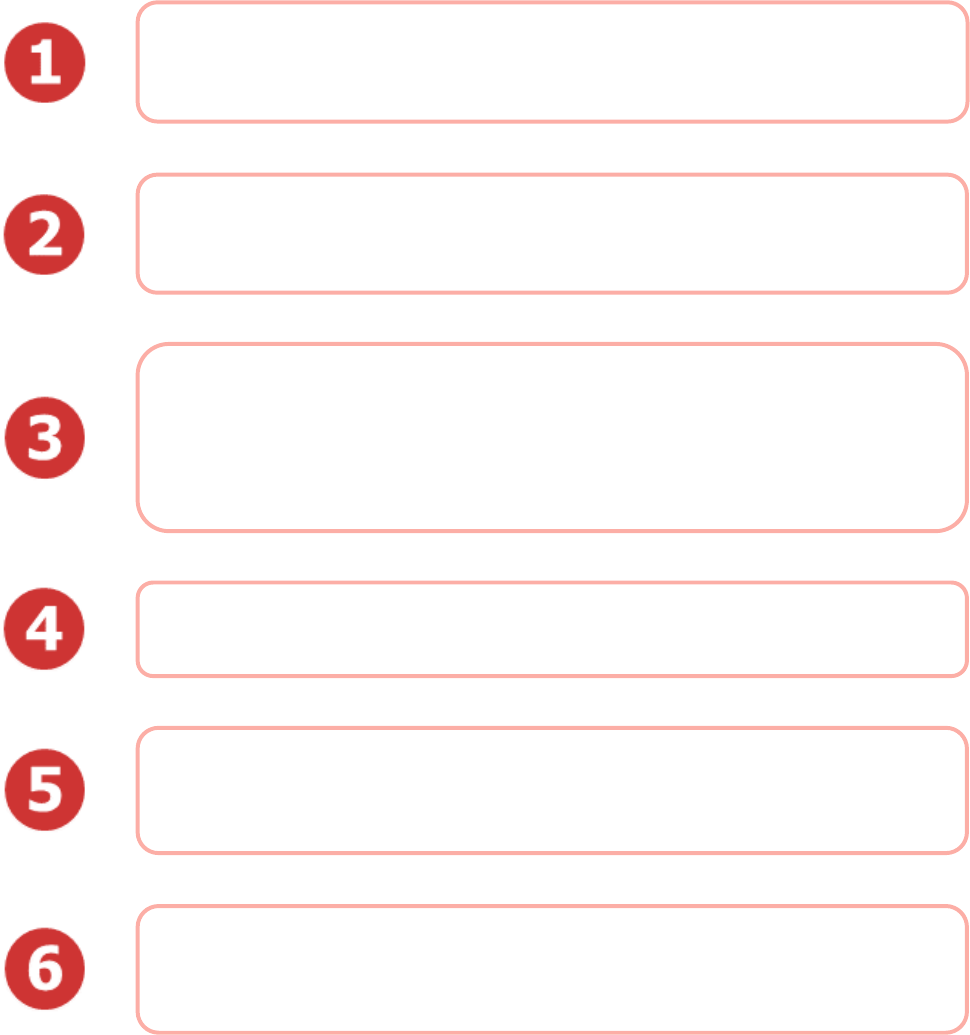
6
A violation column – Many CWSs provide a violation column so that
customers can easily identify contaminants that were above drinking water
standards.
A legible font – Use text that does not contain calligraphy (for example, Times
New Roman, Arial or equivalent). Center all columns except for the Contaminant
column. This makes your CCR easier to read.
Color – Shade each row to make the table easier to read. Try alternating
shades of the same base color in each table or contaminant category. Pick
colors so that the CCR can be easily viewed in all formats. For example, printed
in black and white. Use color combinations that someone who is colorblind can
see (such as, avoid red and green combinations).
More stringent state standards – Identify instances where your state has set
a more stringent drinking water standard than federal standards.
Additional information – In addition to using the required terms, also use
“plain English.” For example, use “Highest Level Allowed” in addition to
“Maximum Contaminant Level.” The goal is to express information clearly.
A “Table Key” – Include a table key on the same page as the table if possible.
Remember, required definitions such as the Maximum Contaminant Level (MCL)
and Maximum Contaminant Level Goal (MCLG) must be included.
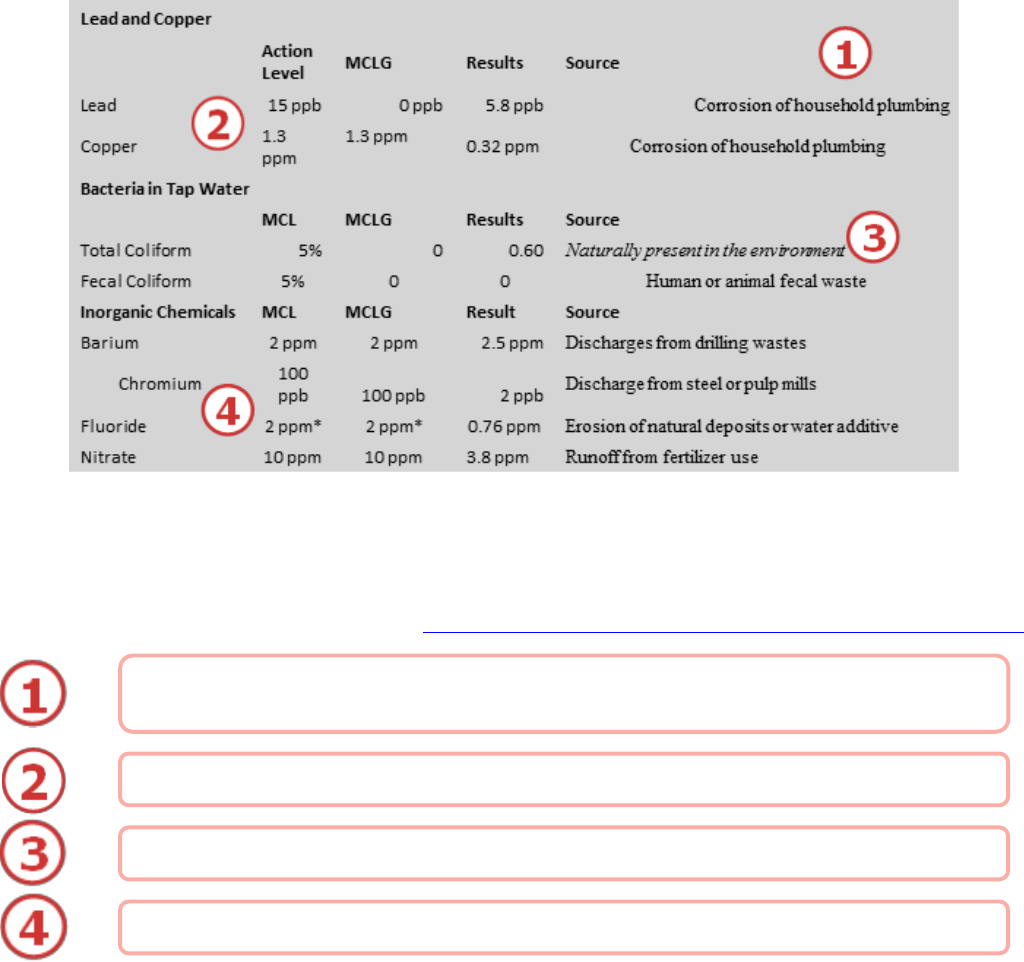
7
What to Avoid When Creating a CCR Contaminant Table?
You want your CCR contaminant table to be eye-catching, easy to read and understandable.
Figure 7. Example CCR Contaminant Table that needs improvement.
Where Do I Find More Information?
The following resources are available to help you prepare your CCR. Remember, many of these information
sources present only “what is required.” The practices in this factsheet can enhance your CCR for your
customers. These resources may be found at http://water.epa.gov/lawsregs/rulesregs/sdwa/ccr/index.cfm.
Do not select background colors or graphics that make the table text hard to see or lead
the eye away from the text.
Do not leave out gridlines or other visual organizing elements.
Do not mix font sizes and styles within one category of information.
Do not mix text alignments within one column of information.
EPA’s CCR Unit Conversion Factsheet (April 2015)
EPA’s Preparing Your Drinking Water Consumer Confidence Report (April 2010).
EPA’s CCR Rule: Quick Reference Guide (August 2009).
EPA’s Talking to Your Customers about Chronic Contaminants in Drinking Water (October 2007).
EPA’s Compliance Help/Tools for CWSs.
EPA’s CCRiWriter. This online application enables you to produce a regulation compliant CCR.

In January 2013, EPA released a memo describing regulatory requirements for directly delivering a CCR to bill
paying customers electronically. This section describes what EPA considers direct delivery of the CCR as well as
recommendations for how to launch, maintain and electronically deliver CCRs to bill-paying customers.
The CCR Rule generally requires each CWS to mail or otherwise directly
deliver one copy of its CCR to each customer annually. In addition, the
CWS must make a good faith effort to reach customers who do not get
water bills, for example, apartment dwellers.
1. Similar to delivering a copy of the CCR through the mail,
electronic delivery must provide the CCR in a manner that is
“direct.” The EPA interprets this CCR Rule requirement to mean that CWSs can use other mailings, such
as paper billing statements featuring a prominently displayed and explained direct website address (or
URL) to the CCR, to meet their CCR delivery requirement. Each year, the CWS must also provide a
method (for example contact phone number) for a customer to request a paper copy of the CCR.
2. If a CWS is aware of a customer’s inability to receive a CCR by the chosen electronic method, it must
provide the CCR by an alternative method allowed by the CCR Rule.
What Delivery Methods Does EPA Consider to be “Direct”?
There are six CCR delivery methods that EPA has identified as meeting the “direct delivery” requirement, so
long as the system is providing the report directly to each customer. These are described in Table 1 below.
Table 1. Approved CCR Delivery Methods
CCR Delivery Method
Method Description
What Is Considered Direct Delivery?
What is electronic delivery?
Electronic delivery encompasses various
delivery methods that include: email,
posting a CCR on a public website and
mail notification of the posting. There
are specific requirements for electronic
delivery of CCRs.
1. Mail - paper copy
CWS mails a paper copy of the CCR to each bill-paying customer.
2. Mail - notification that CCR is
available on website
CWS mails to each bill-paying customer a notification that the CCR is
available and provides a direct URL to the CCR where it can be viewed.
A URL that navigates to a Web page that requires a customer to search
for the CCR does not meet the “directly deliver” requirement. The mail
method used for notification may be, but is not limited to, a postcard,
water bill insert, statement on the water bill or community newsletter.
3. Email – direct URL to CCR
1
CWS emails to each bill-paying customer a direct URL to the CCR on a
publicly available site on the Internet. A URL that navigates to a Web
page that requires a customer to search for the CCR does not meet the
“directly deliver” requirement.
4. Email – CCR sent as an
attachment to the email
1
CWS emails to each bill-paying customer the CCR as an electronic file
email attachment (for example, PDF).

9
CCR Delivery Method
Method Description
5. Email – CCR sent as an
embedded image in an email
1
CWS emails to each bill-paying customer the CCR text and tables
inserted into the body of an email (not as an attachment).
6. Additional electronic delivery
that meets “otherwise directly
deliver” requirement
2
CWS delivers CCR through a method that otherwise directly delivers to
each bill-paying customer and in coordination with the state.
1
This method may only be used for customers when a CWS has a valid email address to deliver the CCR electronically.
2
This category is intended to encompass methods or technologies not included above. CWSs considering new methods or
technologies should consult with their state to ensure it meets the intent of “otherwise directly deliver.
A CWS will need to use a combination of delivery methods to reach all customers.
How Does Outreach Help Me with CCR Delivery?
You should perform outreach to your customers prior
to electronic delivery each year. This is especially
important if you currently deliver a paper CCR to each of
your customers through the mail and will begin
electronic delivery for the first time. Outreach is
different than notifying your customers that the CCR is
available on a Website, or an email with the CCR as an
attachment. Outreach occurs before the CCR is
delivered. It lets you inform customers of your CCR
delivery method plans and to receive feedback on how
your customers prefer to receive their CCR.
Outreach vs. Delivery?
Outreach is when a CWS contacts customers to tell
them that they will be changing the delivery format
of their CCR, or asking the customer’s opinion about
delivery. This can be done at any time and there are
no regulatory requirements surrounding outreach.
Delivery is the regulatory requirement to directly
deliver the CCR to all bill-paying customers and make
a good-faith effort at reaching non bill-paying
consumers. There are specific requirements
associated with direct delivery. For more information
see EPA’s 2013 CCR Delivery Options Memo.
Communicating with your customers that your CCR
delivery methods will include electronic delivery
creates greater transparency between you and your
customers. It shows your customer that you want them
to be aware of the CCR and to read it.
An example of an outreach method is to send your customers postcards with information about the upcoming
electronic delivery of the CCR. You may want to include information such as when the CCR will be available
and where it will be located.

10
Tips: Mailing a Direct URL
The URL must provide a direct link to the CCR and the link must take the customer to the entire CCR so that
the customer does not have to navigate to another Web page to find any required CCR content.
The URL must direct the consumer to the current
CCR posted. A list of various CCRs, including a list of
historical of CCRs, does not meet the “direct
delivery” requirement.
A shortened URL can make customer access easier
and can be accomplished through a third-party
shortening service that creates a website alias or
redirect.
When using a third-party to create a shortened
URL, notify your customers and familiarize them
with the URL.
A long URL increases the chances for customers to
incorrectly type the URL and could discourage
customers to enter the URL.
Helpful Hint
Most website hosting companies allow you to track
website hits and length of stay. The number of hits
will tell you if your outreach campaign alerting
customers to the existence of your electronic CCR
and website is a success or not. If hits are too low,
you may want to increase not only your outreach
efforts but your outreach methods as well. If your
electronic CCR and website hits are high, but
people are only staying for five seconds, this may
indicate that your site is not engaging or it is too
hard to find information. You may wish to work
with your IT staff to improve the look and
navigation of your electronic CCR and website.
Figure 8. Sample outreach postcard delivered before the direct URL has any
information posted.

11
Figure 9. An example of an outreach message on the back of an envelope
from the CWS alerting customers that the CCR will be available online.
Another outreach method is to include a message on billing statements or the outside of envelopes that the
CCR will be available.
As shown in Figure 9, since the URL is being shared as a part of outreach efforts, the URL does not need to link
to your CCR just yet. That is why the phrase “Coming Soon” is used on the envelope. You are not just limited to
these two examples in your outreach efforts. The more outreach you do, employing a variety of methods, the
greater the chance of reaching your customers. Note – if the URL does not have the current CCR posted when
sending out a link, it is not considered direct delivery and does not satisfy the delivery requirement for the
CCR Rule.
Other outreach methods could include:
Social media
Newspaper article
Notice on website
Message sent through a reverse calling system
Article in your CWS newsletter
Handouts at community events
Email to all e-billing customers
Radio ads
By informing your customers of the change to (or addition of) electronic delivery of the CCR it may ease their
transition knowing you still want them to read their CCR. Remember, outreach efforts are different than, and
do not replace, CCR delivery requirements.
If the most current CCR is not linked to the URL that is being mailed out then you are not meeting the direct
delivery regulatory requirement.
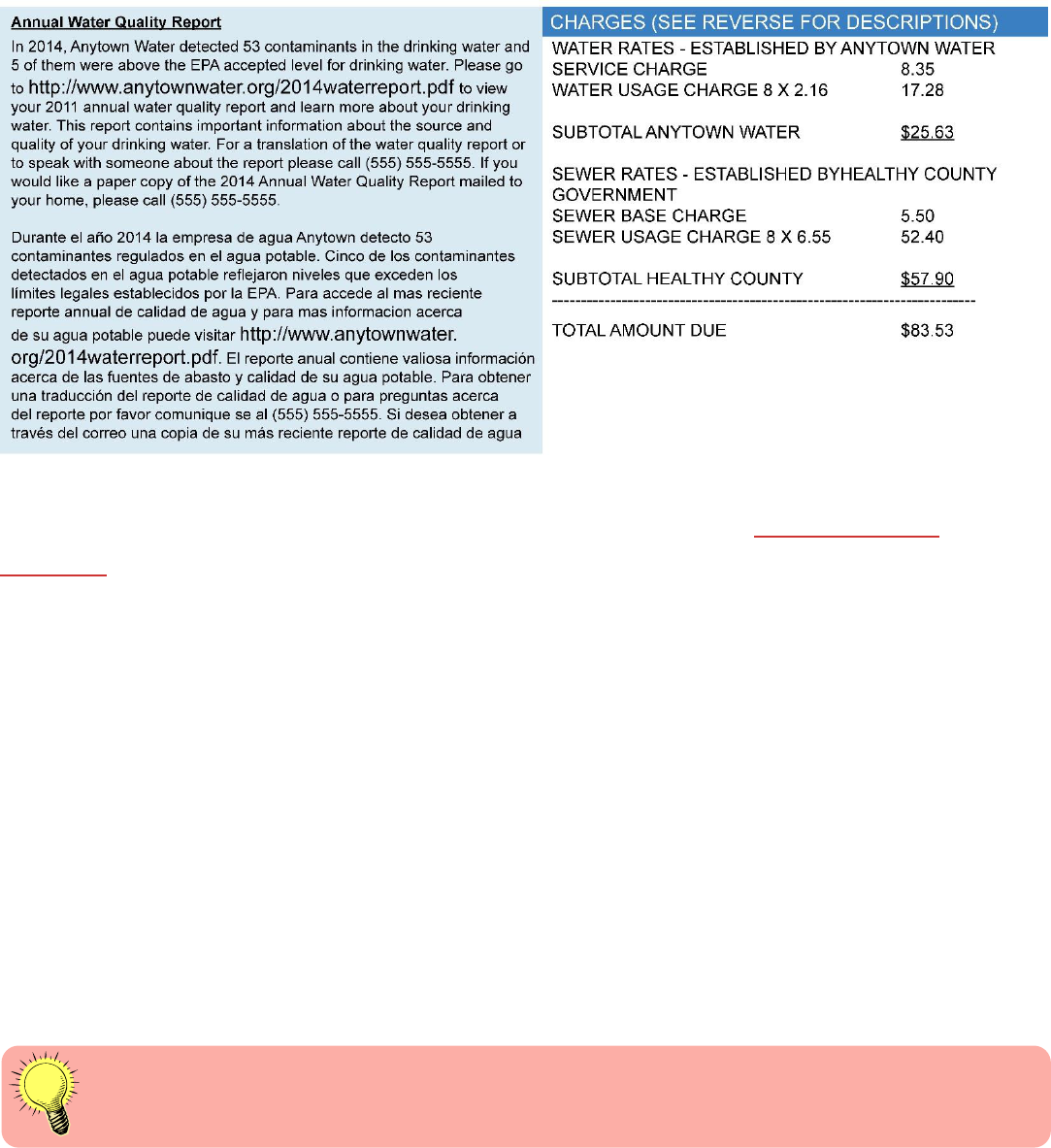
12
Figure 10. Example of a water bill.
What Are Best Practices and Important Considerations for CCR Electronic
Delivery?
The tips below will help you to ensure successful electronic delivery of CCRs. These tips have been arranged
under the broad categories of Before You Begin, Content Considerations and Email Tips.
Tips: Before You Begin
1. As noted above, consider conducting customer outreach to inform them of the option for electronic
delivery. Your customers’ preferred delivery methods should be assessed prior to beginning electronic
delivery. Not all customers have Internet access and even if a customer has Internet access he or she
may still want to receive a paper copy of the CCR.
2. To ensure delivery to every bill-paying customer, you may need to implement a combination of paper
and electronic delivery. Start the development of your CCR early and coordinate with other
departments in your organization that may be involved (for example, Information Technology (IT) and
billing departments). Customers likely will have questions about electronic delivery, and personnel in
all departments will need to have the same information to share with customers. IT staff may need
plenty of time to develop a website to accommodate the posting of your CCR.
EPA’s CCR Delivery Options Memo (January 2013) contains information to help assess which type of CCR
delivery program is best for your CWS.
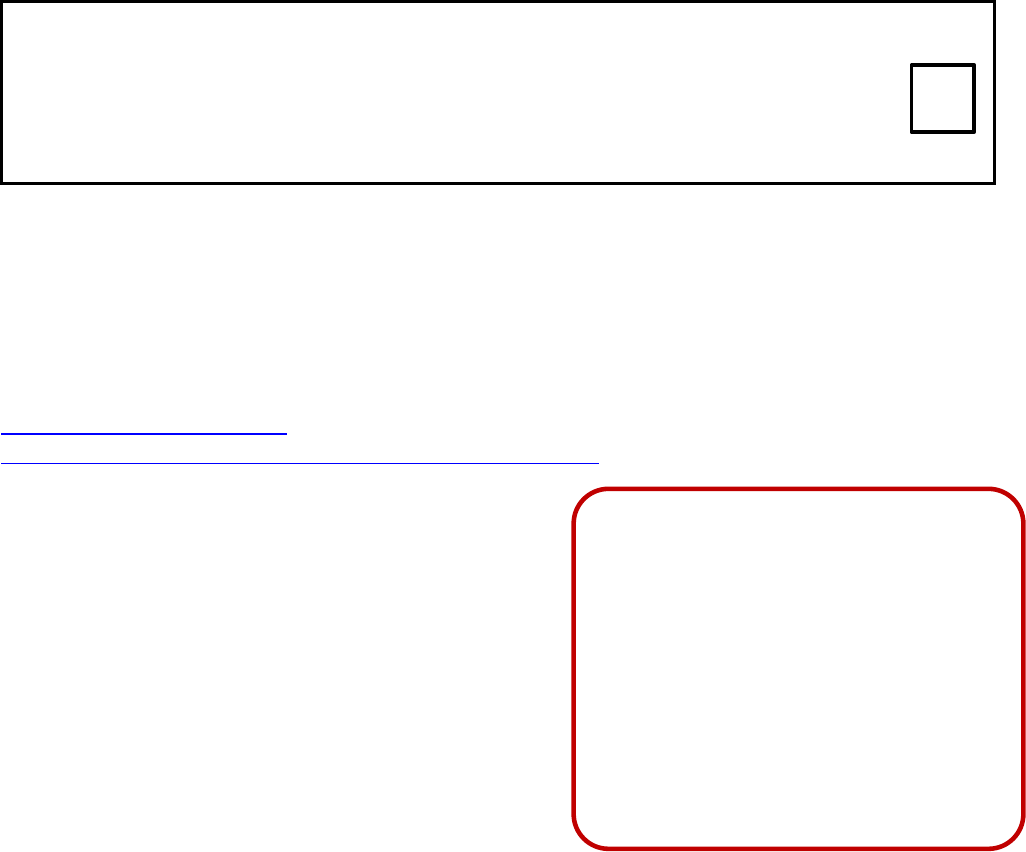
13
Tips: Content Considerations
1. When using a mail notification method with a direct URL (for example, on a water bill), you should
display the direct URL on every mailing throughout the year.
2. If you mail a direct URL to customers, consider including a check box on every mailing (see Figure 11),
similar to a change of address or pay by credit card option, so that a customer can elect to continue
receiving a paper CCR. Be sure to coordinate with the billing department to note those customers who
would like to continue receiving a paper CCR so that one can be sent as soon as possible.
Figure 11. Checkbox for customers to elect to continue receiving a paper CCR.
Please check the box if you would prefer a paper copy of your annual water quality report
delivered to your home.
Por favor, haga una marca en el encasillado si prefiere recibir a través del correo una copia de
su más reciente reporte de calidad de agua.
3. As noted above, the direct URL should be displayed in typeface that is at least as large as the largest
type on the billing statement or other notification. You should also create a short, easy-to-type URL.
This sounds easy, but if your CWS does not have its own website, this could be challenging. For
example, if you will be posting your electronic CCR on your Web page which is on your municipality’s
website, the URL could become quite long. One thing to consider is a website alias or redirect, which
can be obtained through a shortening service. This allows you to have a short, easy-to-remember URL
that actually takes your customer to the Web page with the longer URL. An example of this is
http://epa.gov/watersecurity which takes you to the much longer URL
http://water.epa.gov/infrastructure/watersecurity/index.cfm.
4. When sending a direct URL notification or email
attachment, include a short message to encourage
readership of the CCR (see Figure 12). Remember, the
purpose of the CCR is to inform customers about the
quality of their drinking water and to raise customers’
awareness of where their drinking water comes from
and what it takes to deliver water to their home, as well
as the importance of protecting drinking water sources.
This message is different than the required explanation
of the URL, which tells your customer that the URL links
to the current CCR. This short message should tell them
why they should read the CCR.
Helpful Hint
Once a customer requests a paper or
electronic CCR, keep a record of this delivery
preference for future CCR deliveries. For
those who select paper, you may still wish to
ask them at least once a year if that is still
their preference. This customer may get
Internet access or sign up for an email
account in the future, and it would be good
to remind them of the electronic delivery
option.
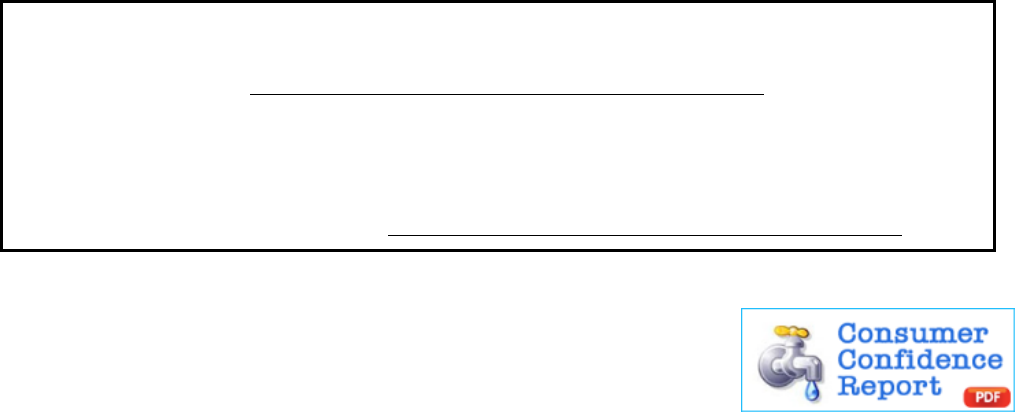
14
Figure 12. Direct URL notification, including a short message to encourage readership of the CCR.
In 2014, Anytown Water detected 53 contaminants in the drinking water and 5 of them were above
the EPA accepted level for drinking water. The Anytown annual water quality report is available online
at http://www.anytownwater.org/2014waterreport.pdf.
Durante el año 2014 Anytown Water detectó 53 contaminantes regulados en el agua potable. Cinco de
los contaminantes detectados en el agua potable reflejaron niveles que exceden los límites legales
establecidos por la EPA. Puede ver en línea el informe anual de la calidad del agua de Anytown Water
visitando la página del Internet: http://www.anytownwater.org/2014waterreport.pdf.
5. You may want to prepare your CCR in a format (for example, PDF) that
can be delivered both electronically and on paper. This decreases the
burden of creating two versions for delivery. Try to make the file size
as small as practicable if you are planning on delivering it by email.
6. The CCR could also provide links to other, non-required information on the Internet that all customers
can visit for more information. This information can be used to encourage your customers to opt for
electronic delivery of their CCR. Advertise the fact that your customers can find out much more about
their CWS by receiving their CCR electronically or by visiting your website.
7. If you are required to have information in your CCR in different languages based on a large portion of
non-English speaking residents, you should also consider including any outreach information in the
other languages.
Tips: Using Email
1. Notify customers early to add your email address to their “safe sender” list to avoid the CCR being
classified as junk mail or being removed by spam filters. Many spam filters look for embedded image
emails and reject them, especially if the sender is not on the recipient’s “safe sender” list.
2. If you send the CCR via email and receive a message that the email bounced back, be prepared to send
the CCR by an allowable alternative means. This means customers may need to be called to verify
email addresses. If a customer no longer has an active email account, this should be noted in your
records and a paper CCR mailed to them.
3. Consider your CWS’s capacity to send large volumes of email and whether a third-party is needed to
manage the delivery of the CCR. Be sure to update your email database regularly throughout the year
to make sure emails are up-to-date so that when you send the CCR you do not get many bounce-backs.
4. Track how many emails are opened to help measure the success of your CCR’s electronic delivery.
Statistics you may wish to track include the open rate (percentage of customers that opened the
email), opened (number of customers that opened the email more than once), and forward opens
(how many times the email was forwarded). You will want to coordinate with your IT department
ahead of time to capture these statistics. Depending on your email service provider, open statistics will
vary. You may need to contract with an outside provider to obtain this information.
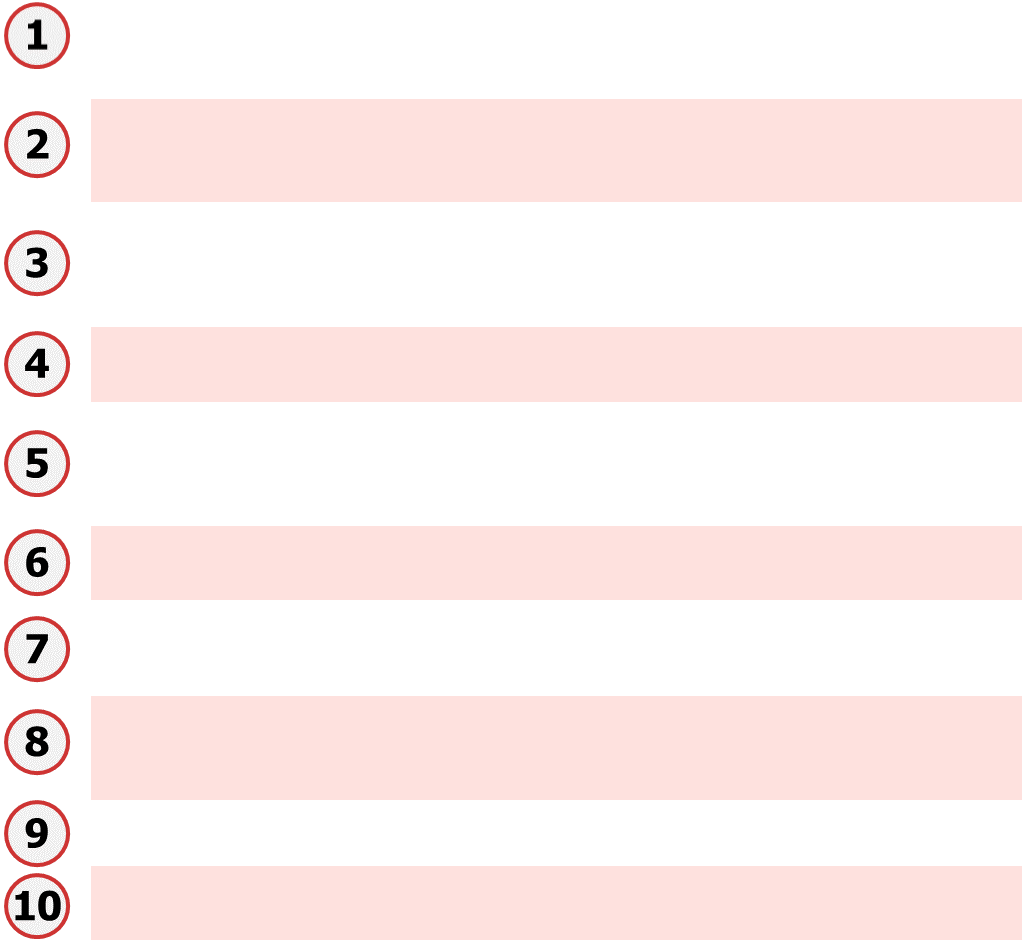
15
5. Electronic bill and auto-pay customers may not open or may ignore their billing statements. Therefore,
to ensure that your customer is aware that the email they are receiving is not the bill or notice of
payment, you should send a separate email (with a CCR-related subject line) to inform your customers
of the availability of the CCR each year. You may want to send more than one email to ensure that the
message is received.
What Are the Top Ten Things to Remember When Utilizing Electronic Delivery?
Delivery is your responsibility! A CWS must certify distribution of the CCR to all customers to
their primacy agency. CWSs will need to use a combination of delivery methods to best
reach customers in their service area.
Know your customer base! Customer surveys show preferences are split between wanting
electronic versus mail delivery of the CCR. Be sure to communicate with your customers to
find out their preferences.
Give customers a heads up and an option! Inform customers of the change in delivery
approach before beginning electronic delivery of your CCR to customers. Remember that it
is a requirement to include an option for customers to elect to receive a paper CCR.
Tell everyone, all the time! A CWS mailing a direct URL should display the direct URL on all
mailings.
Know your costs! You may not see delivery savings in the first year, and it may take a few
years for people to become comfortable with electronic delivery and to maximize
participation.
Catch your customers’ attention! Include a short message in outreach and notification
materials to encourage readership of the CCR.
Be aware of email pitfalls! If an email bounces back, resend the CCR by an allowable
alternative means. Keep email databases up-to-date.
Make it bold! Make it short! The direct URL should be in typeface that is at least as large as
the largest type on the billing statement or other mailing notification. You should also
create a short, easy-to-type direct URL.
Keep a record! Remember your customers’ delivery preferences for future CCR deliveries.
Remind auto-pay customers! To ensure that e-bill and auto-pay customers are aware of
their CCR, a CWS should send a separate CCR notification email.

Where Do I Find More Information?
The following resources are available to assist you in developing a CCR electronic delivery program. These
resources may be found at http://water.epa.gov/lawsregs/rulesregs/sdwa/ccr/index.cfm.
EPA's CCR Delivery Options Memo (January 2013).
EPA's Consumer Confidence Report (CCR) Rule Retrospective Review Summary (December 2012).
Where You Live: Your Drinking Water Quality Reports Online. EPA publicly accessible database of CCR
hosted websites.
Disclaimer
This document provides guidance and contains EPA's current policy recommendations for complying with the CCR Rule.
Throughout this document, the terms “state” and “states” are used to refer to all types of primacy agencies including
U.S. territories, Native American tribes and EPA.
The statutory provisions and EPA regulations described in this document contain legally binding requirements. This document is
not a regulation itself, nor does it change or substitute for those provisions and regulations. Thus, it does not impose legally
binding requirements on EPA, states or CWSs. This guidance does not confer legal rights or impose legal obligations upon any
member of the public. While EPA has made every effort to ensure the accuracy of the discussion in this factsheet, the
obligations of the regulated community are determined by statutes, regulations, or other legally binding requirements. In the
event of a conflict between the discussion in this document and any statute or regulation, this document would not be
controlling.
The general description provided here may not apply to a particular situation based upon the circumstances. Interested parties
are free to raise questions and objections about the substance of this guidance and the appropriateness of the application of
this guidance to a particular situation. EPA and other decision makers retain the discretion to adopt approaches on a case-by-
case basis that differ from those described in this guidance, where appropriate.
Mention of trade names or commercial products does not constitute endorsement or recommendation for their use. This is a
living document and may be revised periodically without public notice. EPA welcomes public input on this document at any
time.
Office of Water (4606-M) EPA 816-F-15-002 July 2015
